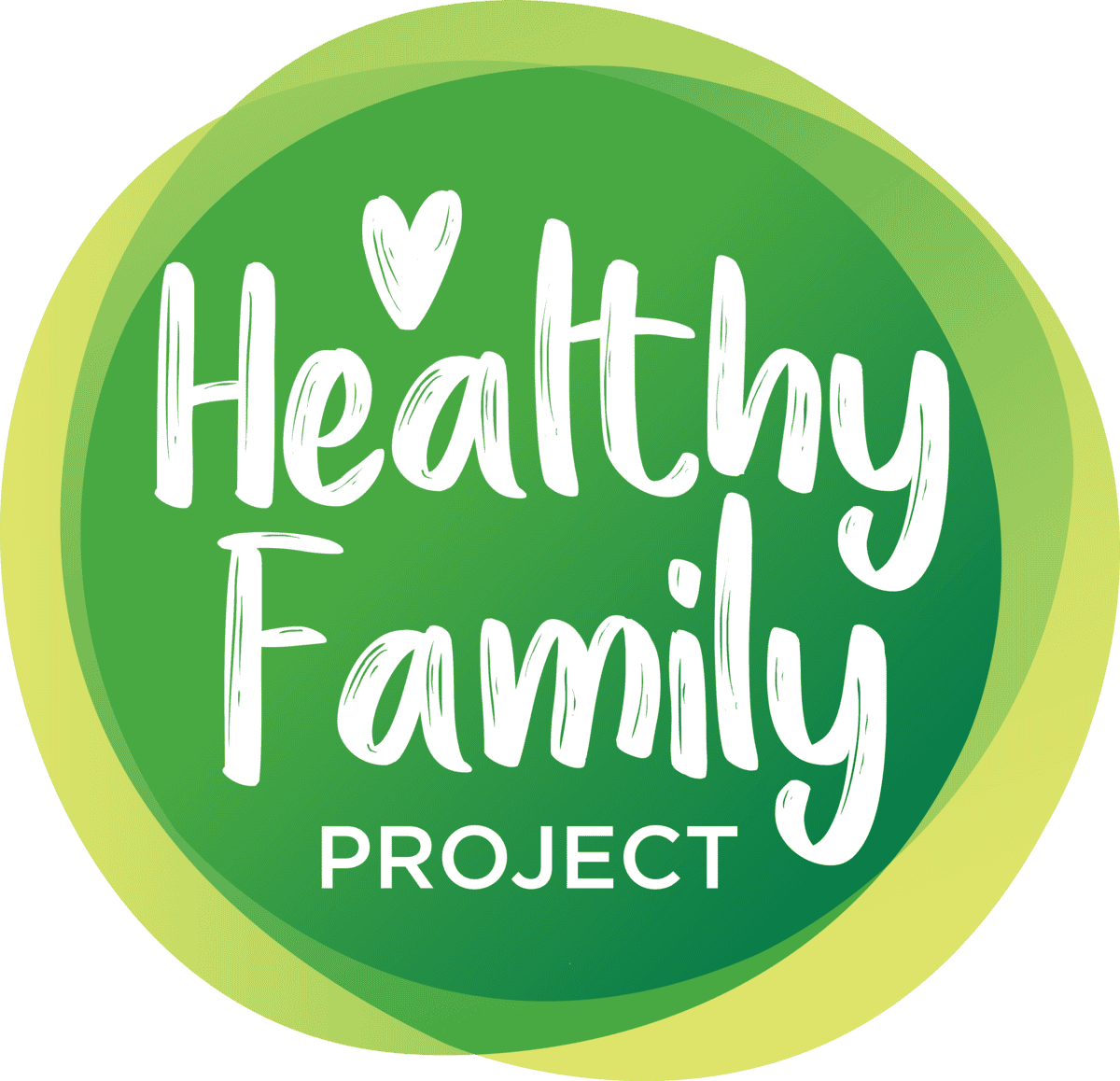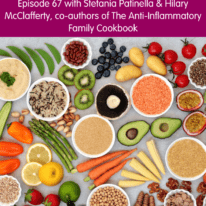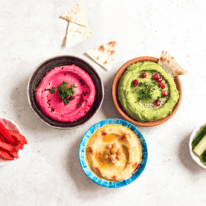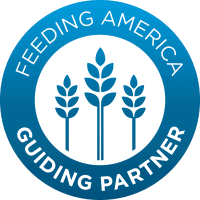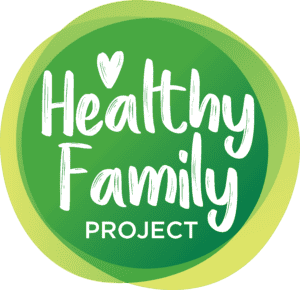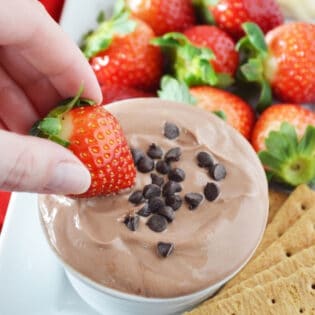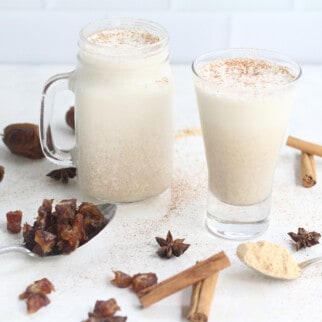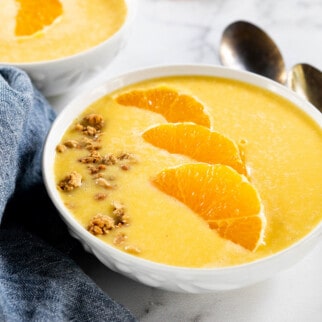Episode 67: Benefits of the Anti-Inflammatory Diet
This episode of the Healthy Family Project podcast is all about the anti-inflammatory diet. We’re joined by co-authors of The Anti-Inflammatory Cookbook. This plant-forward style of eating improves overall health and can prevent chronic and inflammatory-driven illnesses.
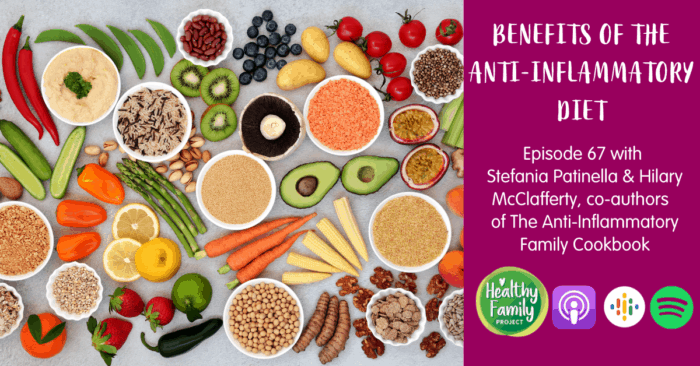
The anti-inflammatory diet can help families tackle health issues like obesity, asthma, inflammatory bowel disease, and high blood pressure. Stefania and Hilary joined us to break down the anti-inflammatory diet and share how they put together a cookbook with 100+ recipes that is mindful of the entire family including guidance for babies and kids.
Stefania and Hilary go back to basics by explaining what is inflammation and how it affects our bodies. They share how making tweaks to your diet and incorporating this style of eating early in a child’s life sets them up for success in health.
Listen to the episode
What We Cover:
Want to skip straight to a hot topic? See timestamps below. But of course, we recommend listening all the way through to get all the great tips and tricks!
- 3:54 Meet Stefania
- 6:05 Meet Hilary
- 7:38 What is inflammation?
- 9:40 What inspired you to create this cookbook?
- 15:28 How did you create the recipes?
- 23:20 How to make these meals baby-friendly
- 31:40 Which foods are the worst for inflammation?
- 36:43 What are the benefits of anti-inflammatory eating?
- 43:01 Hot Takes with Stefania and Hilary
About Our Guests, Stefania Patinella and Hilary McClafferty
Stefania Patinella and Hilary McClafferty are co-authors of the new book The Anti-Inflammatory Family Cookbook. Stefania is a Chef and the Founding Director of the Go!Healthy cooking, nutrition, education, and gardening programs at The Children’s Aid Society of New York City.
Hilary is a board-certified doctor in pediatrics, pediatric emergency medicine, and integrative medicine. She’s the Medical Director of Pediatric Emergency Medicine at the Tucson Medical Center in Arizona and a founding member of the American Board of Integrative Medicine.
Relevant Links
- Defining Diets: What to Know About Popular Diets
- Foods for Gut Health
- Healthy, Energy-Boosting Foods
- Check out Stefania’s website
- Dr. Hilary McClafferty
- Creating Balanced Family Meals
- Herbs & Spices: Foundations of an Anti-Inflammatory Diet
Other Podcast Episodes to Check Out:
- Episode 66: Small Garden, Big Environmental Impact
- Episode 62: How to Avoid Added Sugars
- Episode 6: Mindful Eating for Your Family
Healthy Family Project Facebook Group
Join our Healthy Family Project Facebook group! This group will serve as a safe space for parents and caregivers to talk all about raising a healthy family – from dealing with a picky eater and tips to get more fruits and veggies onto plates to exercising as a family and mental health. We welcome all of you to join in!
Listener Survey!
Thank you so much for supporting the Healthy Family Project Podcast! We’d love it if you could take 5 minutes to let us know how we can bring you the best possible content for future episodes. Take the survey here.
Healthy Family Project Podcast
Conversations covering hot topics in the world of health, food and family with a dose of fun. Helping families ease their way into a new fresh and healthy world.
Be on the lookout for new bi-weekly episodes and don’t forget to subscribe on Apple Podcasts, Google Podcasts, Spotify or your favorite podcasting site. If you like an episode, make sure to leave a rating and comment.
If you are interested in being a guest on the Healthy Family Project podcast, contact amanda@healthyfamilyproject.com with your topic idea for consideration.
Transcript for Episode 67
This transcript was produced by Otter.Ai. Please forgive any misspellings and grammatical errors.
00:09
Welcome to the healthy family project by produce for kids, covering the hot topics in the world of health,
food and family with a dose of fun. Welcome back. I’m your host Amanda, hope you enjoyed last episode
and have your small garden plans in order for spring. I know over here I am in the midst of planting. And
of course I’m in a warmer climate. So I’m already growing a few things, but definitely catch up on the last
episode. Be sure to listen to that and get all the info on starting your small garden that can make a big
environmental impact with Earth Day right around the corner. And could be a fun activity to do with your
family get that garden planned or, or get that you know, small landscaped area going for the summer
months. Don’t forget to join our healthy family Project Facebook group. I love interacting with all of you
over there. And many of our guests are in the group too. So from past episodes, if you want to tap into
their insights direct, that’s kind of cool. We have new recipes, yay. Over on the website just in time for
spring. I know sometimes you know as the seasons change what we’re cooking up in the kitchen
changes as well. So if you need some inspiration head over there. Of course, all of our recipes are
approved by our registered dietician, Sally, cuz Kazem check, excuse me, you may know her from real
mom nutrition.com. She’s also a regular on our Facebook page or a Facebook group. So if you want to
chat with her, she’s she’s in mix. And then all of our recipes are tested and approved by my family and
some of the families on our team. We actually our team creates these recipes in my kitchen, in my home.
So that’s really cool. You get can see behind the scenes, we do a lot of that over on our Instagram. So if
you want to follow us on Instagram, you can see some fun stuff behind the scenes and then also get get
our recipes and different tips over there. Okay, now on today’s to today’s topic, the word inflammation
has become a buzzword when it comes to the health of our families, inflammation in our society, and this
is an ongoing issue, in most cases, relates directly back to the foods we eat. Today’s conversation is an
exciting one full of great ideas and tips from Stefan yet Patton Alya and Hillary McLafferty, two of the co
authors of the new cookbook the anti inflammatory family cookbook. Stefan Nia is a chef and the
founding director of the Go healthy cooking, nutrition education and gardening programs at the Children’s
Aid Society of New York City. Hilary is a board certified doctor in pediatrics, pediatric emergency
medicine and integrative medicine. She’s the medical director of pediatric emergency medicine at the
Tucson Medical Center in Arizona, and a founding member of the American Board of integrative
medicine. These ladies know their stuff, and put it together in an easy to digest, give it I did their
cookbook for families and they even include babies. So let’s get chatting with these ladies right away.
Welcome to the show. I am so excited first time having two guests on the podcast. So I’m getting a little
savvy over here. I am honored and excited to meet you both and learn more about your new cookbook,
the anti inflammatory family cookbook. I’ve had one here as we speak and I’ve taken a little bit of time to
go through it. So let’s kick things off with you both sharing a little about yourselves with our listeners. So I
will turn to you first if Anya if you want to kick it off.
03:55
Hi, Amanda. Thank you. It’s so nice to be on your show. Thanks for inviting us. Sure. Um, so I spent the
last 1517 actually years immersed in healthy cooking with kids nutrition education. I worked for eight
years at a nonprofit called the Children’s Aid Society where we also tackle school for food reform. You
know, kids get fed a lot of processed food in their school foods. And so we scrapped those process
menus or the sort of chicken nuggets and tater tots and such and cooked meals entirely from scratch all
Whole Foods and plant based. And a lot of the recipes. In fact, in this book were inspired by those years.
And more recently, in the past few years, I’ve transitioned to doing my own nutrition and health coaching
practice. And I have to say it’s been beautiful and interesting to move from, like a public health
perspective. You know, where I think the main question that was always on my mind is how can we
create environments that make healthy choices easy for families, right to a question that’s more
personal, working one on one with people, how do you make those healthy choices possible to grab
within whatever your environment is, even when they’re not especially easy. And what I love most about
coaching is just kind of the privilege of being welcomed into one family and one individual’s life and
starting a conversation about health, less from a perspective of problems, how do we solve these health
problems and more from a perspective of strength in setting a vision of wellness, I love that.
05:32
That’s wonderful. And, and I can say, that sounds very rewarding. I know and the work that I do day in
and day out, like, Okay, I need to feel good. At the end of the day, I need to be helping people. And it
sounds like you are definitely helping a lot of families, which is wonderful.
05:50
Yeah, I do feel that it’s a it’s a great privilege. I didn’t think I could be working at Children’s Aid. I loved it
so much. And now I kind of beat it. So I’m pretty happy about that.
05:59
That’s great. That’s awesome. Okay, how about how about you, Hillary, we’ll toss it over to you.
06:05
Sure, and good morning, everybody. So I am a pediatrician, and also a pediatric emergency medicine
physician, who turned to training in integrative medicine in the mid 2000s. And have spent a lot of time in
education in this area. So basically, educating physicians and physicians in training and families about all
the things that we did not learn in medical school. So evidence based approaches to health for children
that expand and build on the conventional approaches. So I spend time in clinical work. And also a
substantial amount of time and energy, which I love in education about these important topics.
06:58
Wonderful. Well, I feel like I have two superstars here with here today with me. So I am very excited to
talk about all things about the cookbook. And let’s, let’s jump right in. So it’s what this cookbook is
awesome. I have been through it. I actually even had my kids, I when I get new cookbooks, I like to have
them go through and and kind of take a look and let them lead and say, Hey, let’s make this recipe. So
we’ve had some fun with that. But let’s start basic before we learn about your vision for the cookbook.
What is inflammation? I know sounds like a very basic question, but definitely a question that a lot of
families have.
07:39
Absolutely. And so I’m going to address this question in a way, the way that I think about it. In a normal
system in a normal body system on a cellular level, when you put in good healthy fuel, it burns efficiently.
And so the system hums along. And if you put in fuel that is less efficient, so let’s say less healthy, what
happens is you get byproducts of the fuel, burning on a cellular level that creates chemicals, sort of
broadly called cytokines, which are unhealthy to the cells. And this sets off a domino effect in the body,
which I think about as sort of a smoldering fire. And things get heated up and hotter and hotter. Until, in
the most extreme case, you’re looking at a you know, sort of a burning fire. Our goal with inflammation in
the body is to cool this down. We want to it’s so much easier to not have it in the first place than to try to
put out a fire, right and so on. Yeah, on a cellular level. That’s the idea. Healthy, efficient fuel, keeps the
body in equilibrium and keeps the system cooled down and very efficient.
09:18
That’s a great, that is actually a great way to explain it. I mean, like I said, it’s a question you think is
basic that that we all know, but it’s definitely a question that’s out there. And that’s, that’s super helpful.
All right. So now we know what inflammation is what inspired you to create this cookbook.
09:41
So in this area, and Stephanie and I are both going to address this question. In this area of nutrition. This
is such an important lever to help the body be healthy. And when you’re working with children. and the
earlier you start with healthy food, the better and translating these concepts into so the science is one
thing. And then translating it into practical application is another. And so I we worked with our wonderful
colleague Maria Mascarenhas at Children’s Hospital of Philadelphia, to take this information that I was
teaching, and she was teaching and implementing in the GI world, the gastrointestinal world at Children’s
Hospital of Philadelphia, and joined with this incredible team. Stiff Anya and Jonathan, and Alexandra, to
bring this idea from the concept the science into the kitchen, and stuff on your I will pass off from here.
11:01
Yeah, thanks, Hillary. Um, you know, in some ways, it was, it started from a conversation that diet related
diseases are a big problem, mostly for adults, right, because as Hillary said, things kind of snowball. And
that usually happens with with age, right. And so we don’t think about these things with kids so much.
And so we hear a lot about the anti inflammatory diet for adults, or anti inflammatory eating or healthy
eating or any number of diets for adults. We don’t hear a lot we hear about healthy eating for kids, but
these terms that are a bit more scientific, you know, anti inflammatory, or not so much applied to kids
food. And we thought that kind of did a disservice. Like why not really explain the science from the get
go, again, in the interest of prevention. The other thing we kind of just loved about this project is that it’s
pediatricians and chefs working together, which we think needs to happen more. Because, you know, it’s
like bringing the, the the doctor’s office into your kitchen. And so we did, we talked to pediatricians and
three chefs and combined it together and came up with a bunch of recipes that we hope your family
loves.
12:17
I want to I want to say one thing, it was very fun to work on this project, and what a great group. So we
we all learned a lot and had a lot of fun on this. And I think that comes through in the book,
12:31
I was just gonna say that I do think it comes through in the book, for sure. And here at healthy family
project, we, I feel like we share similar vision, we started a video series, it’s called Food RX. And we work
with a dietitian, and she helps kind of navigate, you know, foods to, you know, foods for gut health foods
for so everything is foods that are foods for you know, and she covers off on those. So we are big
believers, you know that what you’re consuming as a child and as you grow, really sets the stage, you
know, for adulthood. And I mean, really, who wants to backtrack? That’s the worst. Like, we want to set
ourselves up for success. So, you know, I know it’s, it’s hard, you get to a certain point, and it’s like, Oh,
my goodness, I have to completely change everything.
13:30
Yeah, that’s, that’s, that’s really, that’s the beauty of starting young,
13:34
I think to on that point, the studies clearly show that prevention and kids especially around obesity, for
example, is critical, because there are very few approaches that are successful. Once that cat is out of
the bag. It’s doable, but it’s very difficult. And so we really want to emphasize that from the get go. And
there’s a lot families can do you know, this is within your grasp to do this in your household.
14:09
I think so I think sometimes when you look at it, it seems hard to do. But I work with here in Orlando,
Arnold Palmer Children’s Hospital, I work with their health, they have a healthy living team and they work
with children who have been diagnosed with a call lifestyle related diseases and so that, you know, the
obesity and the diabetes and things like that fall into that category. And we, we see a lot of times that
what we do is we educate the entire family. So we host a series of classes that they come to, but it’s
required for the whole family to attend because we’re changing the habits of the entire family and not just
the child that’s been diagnosed because oftentimes it’s habits that have been formed over for a lifetime,
and if you don’t break through and break those, they continue to manifest generation after generation. So
I am definitely with you guys on this. Alright, so we talked a little bit about having fun with the cookbook.
Now let’s find out how did you create these anti inflammatory recipes? Was it a joint effort? It sounds like
you had a fun team. And I’m sure your families probably loved being taste testers in the mix.
15:28
Indeed, yes. Well, with five authors, everything in this book was a joint. Yes. It was really? Yeah. Lots of
conversations over over two or three years. Wow. Yeah. So we have three chefs took the lead on this
book. It was Jonathan Deutsch, Ali Romi. And me. And we lead the way on recipe development and
testing. I sometimes we started from an idea we were curious about or you know, like any show, or from
one of our family’s recipes, and sometimes we started from a particular ingredient. We really wanted to
foreground leafy greens and cruciferous veggies means sweet potatoes, mackerel, salmon, actually
have to say we had to be really disciplined about sweet potatoes. I don’t know how you feel about them.
But the three of us found that they were like blue vegetable that we had in common that one and
cauliflower, and they just found their way into every Yes. Putting them.
16:28
That’s how my family is like that with brussel sprouts, but they’d love everyone loves brussel sprouts, so
much that everything I make and like Gosh, everything I make them weaving in Brussel sprouts, but I
know they’ll eat it.
16:38
Yeah, great. That is definitely not a bad thing. So variety, variety, variety, variety, that was kind of the
message that we preached in the more science based chapters. And that’s what we really wanted to
demonstrate in our recipes. The other thing that drove the recipes were herbs and spices. And this is a
thing that I think is really unique about this book. We built nearly all of our recipes around homemade anti
inflammatory urban spice blends. Like for example, one is our sweet spice blend has cinnamon and
cardamom, and star anise and clove. And so we we basically, you know, herbs and spices, we feel like
we’re overlooked in dietary recommendation, yes, my plate or the food pyramid before it and many other
versions that are cool around the world, you rarely see herbs and spices on there. And in our own anti
inflammatory table, which is a visual guide that Hillary created, which is really beautiful. We put herbs
and spices just above fruits and vegetables. In other words, they’re at the foundation of a healthy diet.
And one of the reasons we did this was due to two main reasons. One is that herbs and spices are some
of nature’s most potent anti inflammatory foods, right, they’re like, if you think of a square inch kind of
basis, there’s more, you know, phytochemicals in a greater concentration in there than there are in many
other foods. And you can, you know, there’s tons of science on this, but you can also just tell with your
own senses, the colors and the flavors and the the aromas are very potent, and that indicates a high
level of phytochemicals, flavonoids, etc. I mean, think about the fact that, you know, you would never eat
like a spoonful of clove or, you know, like a salad of parsley, although, I don’t know, I might.
18:32
I was just gonna say my, my, my 10 year old is a strange bird. She likes things very plain, and I have an
herb garden and she will pull the mint. Nice and eat. And I’m so amazed by it. And she’ll do the same
with basil. And then my older daughter is like, what are you doing? I cannot even imagine me too. I’m
like, Well, I guess it’s okay. Go ahead.
18:56
Yes, definitely. Okay. I like it. And I think she’s developing a great palette that way, actually. And so, you
know, that’s one of the reasons just the, the the health, the health benefits of the herbs and spices. And
the other reason is kind of what you’re indicating. They’re incredibly tasty. And so they give food, its
cultural kind of footprint. And they make it tasty, and they do this around the world. So we did not
obviously want bland food to be the anti inflammatory diet. That’s not what we think it is. Spices are kind
of the key there. So that’s, um, that’s the thing we thought was really important actually have some of the
spice blends on our website. So people can see that it’s Oh, good.
19:42
Yeah, we’ll link up to in the show notes. We’ll share links and we do a blog post as well around the
podcast. So we’ll link up to everything and anything that that we chat about for sure. I I love the spice. I
love that you’re talking about that, because I think like you said, sometimes, sometimes when people
think about making a change in diet, they’re like, I’m gonna have to eat this bland food, or I’m gonna
have to eat, you know, this non, won’t be flavorful. And I’m going to miss out on that. And so I do think
that including, you know, the spices and showcasing that and making this, you know, the anti
inflammatory foods and recipes, flavorful, goes a long way.
20:32
Yeah, and one more thing I forgot to mention about the space was, is that we wanted to make this easy.
So yes, not an Ellie and I are all chefs. And even us, I have to say the three of us really compared notes
and having the spice blends pre made, which takes all of five to 10 minutes, you know, once a week,
once a month, depending on how much you make, and having them on your shelf already made means
that you’re reaching for one jar instead of five jars, six jars for three jars. And that really makes a huge
difference in whether you put all of these spices in your food. So that was another thing.
21:07
Well, and I can tell you, this is true, because when you’re in crunch time during the week, I forget who I
was just talking to about chopping. I said, I know it sounds silly, because how long does it really take you
to chop an onion or chop some sweet peppers, I said, but if I chop on Sunday, I am much more likely to
grab those and dump them into whatever I’m making. Then, you know, even though it only takes five
minutes or 10 minutes, I sure as heck I’m using the chopped and sometimes just nixing the onion or
whatever it might be if I don’t just don’t have the time to shop it.
21:49
Psychological easy. These onions that are just there for me to grab. Look at these spice blends in my
you know, show.
21:55
Yes, exactly. And now like my girls are older, so I have them in the mix when we do grocery shopping on
Sundays. Or I do groceries now. You know, now things are so different. But what are groceries arrive on
Sunday, they before I put anything away, I have them come in and say let’s do it. Let’s before we even
put it before it even has a chance to go into the fridge or into the fruit basket or on the counter. And it’s
spot. Like let’s just take care of it now. And so I’m fortunate that sometimes they gripe about it, but then,
you know, put on some music and they’re fine. Yeah. Wonderful. Well, so I don’t currently like I said, My
daughters are older now. I don’t have a baby in the house currently sad. But you know, a different
different phase, I guess. But I was very appreciative that each of your recipes offers a way to serve the
meal to a baby. And I actually on our team, we have her name is Amber and she has a little one is about
one and a half. And I like came running to her saying oh my goodness, I can’t wait for you to see this
because she is always looking for ways to transform her family meals into meals for baby. So I feel like
all cookbooks need to do this moving forward. If anyone listening if you’re gonna write a cookbook,
please include this. So what was your thinking behind it? Why did you decide to include this in the book?
23:22
This was really important for us. And yeah, I totally agree more books should have it. I think the most
important reasons we wanted to include the baby food at the bottom of each recipe is because we were
trying to impart the idea that baby food and kids food is not or that they shouldn’t be a whole separate
category from adult food. Right? Like in some ways, it’s this idea of kids food as a separate category
that’s partly at the core of you know, critical picky eating, where kids only have like, they’re five food
groups of pizza, the hamburgers and the fries and stuff. And babies and kids learn in science is very
clear about this as is you know, tons of you know, tons of experience all around the world, grandmas and
you know, cajoling their babies. Babies and kids learn what they like, based on what kids around them
are eating, and based on what they’re exposed to are generally speaking. And one of the core things we
strove to teach in this book is how to raise quote unquote adventurous eaters as we have called them
the Children’s Aid Society, like how do we make this an adventure? And when I say like, really become
adventurous eaters from the start, I really mean, you know, from the start, like babies taste preferences
begin to develop in utero to you know, depending on what the pregnant mother eats. Those aromatic
phytochemicals and veggies and fruits and herbs and spices especially get diffused into amniotic fluid
and breast milk. And then once kids start to eat solid foods, the kita Healthy Eating is to expose them to
a super wide variety of flavors. And, you know, I don’t know, you probably haven’t done this in a while
because you don’t have babies. But I don’t know if you’ve dug into a jar of baby food recently, but it’s
really hard to tell the flavors apart. Like, there’s like bananas kind of tastes like plums. Apricots in the
carrots kind of tastes like, you know, squash and it’s true. It was in peds like everything has this very dull
note. And part of that is because it has to be really ultra cooked in order to be preserved safely. Now, we
think, Okay, if you just take a few pieces of, you know, fennel, or should talkie mushrooms, things that
are usually not in jars for baby food, but there are no recipes, you cook them up really simply, you know,
eliminate the salt, saute them in some oil or steam them, you mash them up or blend them quickly. And
there’s so much more vibrant. That’s an actual flavor that’s new for your kid. And that is the key to
raising, you know, healthy adventurous eaters. And sometimes it is as simple as mashing a banana but
even that banana freshly mashed is tastes like a banana. So that was really important for us. We also
suggest modifications for toddlers, um, my experience and this isn’t all toddlers, but a lot of them kind of
you mix too much ingredients together on one plate and it elicits a reaction. Yes, yes. For example,
tacos, you know, there’s our fish tacos, they have fish in them, they have a slog, they have a pico de
Gaya, guacamole, there’s all these components. And adults generally love to pile all these things into a
tortilla shell fold it up and taste it all together. And many toddlers want separate, quote unquote,
deconstructed on their plate. And so basically, for us kids food, it was mostly adult food in a different
format and putting that baby food. Note down, there was a way to help parents wrap their brains around
the fact that the whole family is eating the same meals just a little bit different format,
27:02
which is such as like a stress reliever, that you know, cuz I know so many parents that make, you know,
they’re like, short order cooks. They’re making like three different things for dinner. And I know
sometimes it’s, you know, he got to do what you got to do, but I have my, she’s 10 Now, but she’s still a
deconstructed eater. She, she eats it. But you know, she’s, she’s the one that eats the mints. She likes
everything. And then my older daughter has has just devoured anything you put in front of her from the
time she was born. And she always says, Well, you didn’t do that for me. And I said, it’s not that I you
know, it’s not that I like her more. You just did it. I didn’t need to do that for you. You know, it’s just like,
What are you doing?
27:53
Yeah, there’s one other there’s one other point about this, that I I just want to make briefly is kids food,
you know, the marketing and advertising that goes towards marketing, direct to children, even toddlers
on television, on the, you know, iPad, and so forth. It is a multi billion dollar industry. And I think it’s really
important for parents to be able to say, wait a minute, you know, normal, regular, healthy, simple food can
be made delicious. And so there’s a two points here. One is a big cost saving, you don’t have to buy the
dinosaur shaped, you know, chicken nuggets, or whatever those are. And, you know, so you can take
back control of that. And the to be aware of the the pressure of this big industry that’s educating parents
in a way that might not be accurate.
28:55
Right, I agree with you. I have I, you know, it’s so hard to stay on top of everything. And all the influences
that come at kids, especially as they start to get older to you know, things that they’ve always sadly, you
know, even in the lunchroom, it’s kind of like, oh, what’s sad, you have hummus that stinks, you know, or
whatever. And I’m like, why are you food shaming my kids? Like please they’re there they’ve been fine
and now all the sudden you know, you have these different influences coming at you but I always tell my
10 year old she sees you know, an ad or whatever and like, Oh, I really want to buy those muffins next
time you go to the store can you buy them offense? like well how about we look for let’s make some of
our own let’s find you know, so then I’m like feverishly like healthy version of Googling, like, let me
combat this before I’m like, you know, stuck at the grocery store trying to buy these blueberry muffins that
she wants so badly. But yeah, I oftentimes let them when they find something they like I say, Let’s took a
Pinterest and you’d like I said, I let them look at the cookbook and kind of pull some things that they
wanted to try. I find that that’s been a better strategy over the years for me is letting them have ownership
because they don’t want to. They don’t. If they choose it, and they’re involved in making it, then
oftentimes they’re not going to want to say, Oh, I don’t want to eat that. Because I’m like, well, there’s
your idea. I had nothing to do with it. It was all you.
30:28
Yeah. So I love the chapters in the book that it’s threaded through that teach parents or encourage
parents to bring kids into the kitchen. I think that’s
30:39
incredibly valuable. You really is on many levels, right? You get the extra help, and they take ownership.
30:48
People underestimate this extra help thing. No,
30:52
I know, that’s even with lunchbox packing, we talked about, you know, giving parents the tools to pack a
lunchbox and I’m like, wait a second, we need to stop this propaganda right now. The kids, I promise
you, at a very young age are able to put together a bento box to their liking that they’re going to eat. So
all right, flipping the script a little bit. I don’t ever like to, you know, go on the negative side. But you don’t
have to give me a full long list, I guess. But if you had to say, foods that are the worst for inflammation,
you know, what, what causes inflammation? What? What can we what’s the shortlist? Or the short tips
that we can avoid? When making you know choices at the grocery store?
31:41
Right, I think that the easiest answer is to go back to the analogy of the clean burning fuel. So if you just
visualize the difference between a processed food, something off the shelf that is highly processed, or
envision a fast food, burger and a large side of fries. Compare how those burn are used in the body to for
example, like a beautiful bowl of berries or oatmeal or a whole grain, much more efficient fuel. When you
use the processed food or fuel, you get a lot of those unhealthy byproducts. So I think that’s really the
easiest sort of simple message is try as best you can to avoid highly processed foods and steer away
from things that are you know, fast food or highly greasy, fatty foods of that nature in the drive thru.
33:00
Yes, I that’s that those are good tips. I often ask my daughters, how many steps did it take to get to you,
which I know is funny, but it got their wheels spinning. And they’ve an I started I set it just you know, on a
whim a couple years ago. And they both think they both say they’ll look at something and they’ll laugh
and say, you know, maybe it’s like, Sour Patch Kids or something. And they’re like, I don’t know how
many steps this took to get to me? Is it okay for me to eat this? And like, well, as long as it’s not like your
every every meal, you’re eating sour patch kids, because they’re like, I don’t even know what kind of
plant this would have come from.
33:49
The origin of this tree.
33:51
Yeah, so they’re like, that’s, that makes sense. So that was like an easy way for me to share with them.
Like, think about what you’re eating and how many steps it took to get to you because, like, they weren’t
grasping, like the processed foods concept, you know, cuz I’m like, well, they’re processed, and they’re
like, We don’t know what that means. Right? What
34:10
does it mean? I love that example. The more natural the better.
34:17
Yes. So I think that that was a way that that stuck with them and kind of funny because they bring it up a
lot to joke about it with the candies and things like that. What treated this girl on? Is that I don’t know. But
if you find it, you’re gonna make a lot of money if you find a tree that grows sour.
34:38
So, I’ll go ahead, add that because, you know, this question comes up a lot and again, we you know, just
like you we didn’t want to like pedal in the negative, right? We want to talk a ton about the negative,
better to talk about what to eat and yes, in some way. And also, you know, There, we did break down
some of the most, you know, commonly found preservatives and chemicals in food and in packaging,
and in artificial sugars, and some of the research that accompanies them, and shows that there are no
endocrine descriptors or other things. So we, you know, we did take some pains to kind of point out
some of the things that are on your labels that you might not know what they are. And it was really an
education. For me. I mean, diving deep into the literature on this stuff was not a happy place to be for a
little while, but we boiled it down. And so there’s some good information in the book about that, too.
35:41
There is and I will say, I have the book in front of me, I had to flip back to it because I said, I know that I
read, I was reading about artificial sweeteners that I I laughed because it says saccharin, and then
parentheses, pink packets, yeah, aspartate blue packets, I was like, yes, thank you for that. I needed that
color a call out because then I was like, this is something I’m gonna remember. Yeah. I love it. There’s
definitely a lot of info. You know, we talked a lot about the recipes. But I will say, for anyone listening, you
will get all the info, before you dive into the recipes, a lot of what we’re talking about today, but so much
more, you know, of the understanding behind the anti inflammatory foods and all of these things would
just dives into the questions where we’re asking today, just a little deeper. Okay, so bottom line? What
are the defined rewards to following an anti inflammatory lifestyle, I guess, the anti inflammatory diet?
36:45
Okay, I’m going to start with the nutrition part of the answer to this question. It’s all about prevention. And
you can link the food that you put in your body or your child’s body to healthier heart, healthier blood
vessels, healthier liver, healthier brain, and so forth. So it is all about keeping the body in good shape. So
as the child grows and develops, that idea of the sort of smoldering fire is kept very cool. And what that
does is it leads to much healthier development of all the body organs as the child grows. And why that
matters is because that sets the child up to avoid preventable chronic illnesses, such as obesity or
overweight, and can help reduce risk for inflammatory driven illnesses such as asthma, childhood
arthritis, for example, we’re seeing a lot of inflammatory gut diseases, and so forth. So the whole idea is
set your child up to be as successful in health as possible.
38:12
I love it. And ever any get to feel great. Your body just feels good, too. Right?
38:18
That’s right, you feel better, more energy?
38:21
You bet. Yes, we can all use that.
38:24
And to piggyback on that, the the other benefit that we talk a lot about in the book is, well, we talk about
balancing what you eat with how you eat, and we we take a lot of time really to talk about the context of
eating. Because we want the other tangible benefit for this book to be that your child and your family
have a happy lifelong relationship with food. Yes. So that that doesn’t mean you never eat sweet things.
It doesn’t mean it doesn’t mean you never eat junk, it means that you know how to moderate this stuff.
Like you know, you don’t get caught up in the cravings of it and there’s some really concrete tips for how
to do that. Some of them are things like you know How to Make mealtime social and the benefits of that
again, all of this is totally backed by many studies but a lot of science about kind of how to enjoy food
together through mindful eating you know, we have some mindful eating guidance in here. Turning off
screen using descriptive language for food so for example, getting kids away from this and adults away
from this kind of dichotomous black and white language. I like it I don’t like it too delicious. What about
what does it feel like in your mouth? Is it crunchy? Is it squishy? Is it right, eat you know, start to have a
more nuanced understanding of food. Other tricks are not snacking a ton, you know not getting
arguments with your kids about it. And so we break all this down. Because we’re looking for kind of the
bigger picture here, right? Like the the nutrition is, is the is the is the end, in a sense, but the nutrition like
the food has to get into the body in order to be nutrition. And for that you need a healthy relationship with
food in the first place that sort of psychologically healthy, socially healthy relationship with food.
40:25
That’s a really good point to mention. I, it’s escaping me what episode number it was at this point, but I
did have a guest on and we were talking about, you know, making meal time how meal time, you know,
back in the day was like, my dad talks about, you know, the rigid, like, you know, you were seated and
you had good posture, and not that those things aren’t in the manners and aren’t important. But, you
know, my doubts, let’s say, I really didn’t like dinner time, because it was like the time where it was like,
What did you get on that test? And like, what did you know, like kind of that just not a pleasant
experience. And I started thinking about that. And I thought, You know what that is important. I mean, I’m
talking about dinner in that regard to make that time and not stressful time. You know, where you’re here.
You talk about different things, and it’s a happy time and it’s a family time and there’s not screens and
you can you know, sometimes those table tops, they’re like conversation starters, especially because I
have a teen and tween now so that fortunately or unfortunately for me, they don’t have a problem talking
but I know some families do have you know, as they get into those teenagers find roadblocks with
conversation. So sometimes those Table Table talkers are like conversation starters. You know, if you
had a million dollars, what’s the first thing you do? Or you know, those types of things that get
conversations going? And then the relationship with food, I think, you know, can become become better.
Although it is funny in that conversation. I think he said, you know, have different themed culturally
themed nights and one night eat with your hands like they do, you know, in this location and so of me, I
made the mistake of mentioning that to my kids, so and she she brings it up the 10 year old brings it up
constantly. What am I can you please use your fork? You have utensils she was? Well, you know, in
some cultures they eat with their hands. Ah, why did I ever mentioned that? So, good stuff. Alright, so
before we finish up I want to do I’ve been doing these hot takes, which are just silly and fun. So play
along with me. I think it’s the final You go first. This is the first time I’ve had two guests. So I guess Hillary
gets the upper hand she can think so just answer. You just I’m going to say two things and you pick one.
Okay. All right. Here we go. Coffee or tea?
43:06
Oh, oh no. I’m about to blaspheme my own culture because I’m Italian but tea.
43:12
Snowy getaway or beach vacation.
43:15
Beach Vacation all the way. fruits or veggies?
43:21
Phone call or text? Ooh, it’s a tie. Yeah, you’re gonna be a tie. That’s okay. Facebook or Instagram, or
Instagram. 100%. Okay, or this is weird, but I just I was researching these, this or that? And this one
intrigued me so cups in your cupboard. upside down or right side up. Oh,
43:42
right. Right side up. You know with the Yes, yes.
43:49
All right, Hillary your turn. Let’s go back to the beginning. All right. Coffee or tea. Coffee. Me to get away
or beach vacation.
44:01
Beach Vacation please. fruits or veggies? Veggies this month is the focus. Yes,
44:08
veggie person myself phone call or text. Your phone call? For sure. Facebook or Instagram.
44:15
I’m taking a break from social media right now.
44:18
I was gonna say or neither because I’m on the neither vote right now. So cups in your cupboard upside
down or right side up, right side up. Okay. All right. That was fun. Thank you both for joining me today
and sharing lots of great tips and ideas for families. We will definitely link up for listeners to buy their own
copy of the cookbook will link to the website. Any other links that you guys want to share information that
might be helpful. We’ll we’ll post all of that. So before we close things out. Can you tell listeners like i said
i’ll post all the links but if there’s anywhere else where they can find and connect with you
45:01
Um I guess through my website which is seed to table.org like as in food goes from the seed to your
table and and then I get lucky my Instagram is just my name very creatively So
45:15
Stefan You know me too I’m an creative as well
45:21
yeah I
45:22
mean we have healthy family project is is the the main one but for me personally it’s my name
45:29
yeah and that those are the two best ways
45:33
and for me I have an educational Academy called the Academy of Pediatric integrative medicine where
there are parent and clinician resources and information. So a p i M dot O RG and then Dr. McLafferty at
a p i M dot O RG is probably the easiest way to find me.
46:01
Wonderful. Well thank you both so much. It was great to speak to you and I look forward to making more
of these recipes.
46:08
Thank you so much.
46:10
Great episode today. What what just an awesome conversation. I can’t wait to try more of the recipes in
this cookbook. If you like the healthy family project, which I hope you do. Please tell a friend or leave us
a rating. It will only help our visibility so we can continue to create a healthier generation. If you want to
tweet with me. I am at Amanda M Kiefer on Twitter and also the same on Instagram. And then you can
find healthy family project on Instagram, Twitter, Pinterest, Facebook and YouTube. Be sure to subscribe
Talk soon
